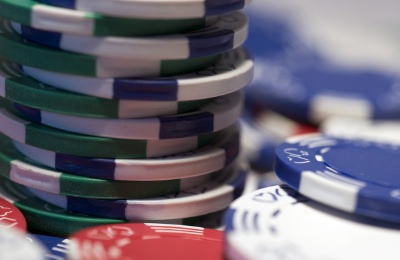|
|

Pot -
1. The amount of money in the center of the table that stands to be won or lost on any given hand.
2. To wager an amount equal to
the pot in a pot limit or no limit poker game.
A poker game is composed of an endless string of “hands.” Each hand is a competition between players, who wager sums of money, called
“bets” in an attempt to win a larger sum of money called “the pot.” As a hand progresses, all of the bets go into the pot, making it
larger and more desirable. Additional cards come before each round of betting, often changing each player’s probability of winning as
well as their incentive to bet. If any player decides to put money into the pot, other players must either follow suit or throw their
hands away. Each player acts in turn, and during each turn it is up to that player to make a value judgment about whether or not it is
worth it to continue on in the hand. A player must consider how big the pot is, how much it costs to continue on in the hand, and what
they expect their chances of winning are. If a player knows these three things with relative certainty, they can figure out whether it
mathematically makes sense to continue, based upon the risk-reward scenario. This is called calculating “pot odds.” If the player
incorporates likely future events into the scenario, it is called calculating “implied pot odds,” or simply “implied odds” for short.
Ultimately, the goal in a poker game is to win money, not to win every single pot that is possible for you to win. Some players
have a hard time making that distinction. There are many times when it is still possible for you to win the pot, but your chances of
winning are so slim that it makes the bet too large and not worth calling. If you insist on calling in this spot, because of the law of
averages, you will lose a substantial amount of money in the long run. So if you want to be a winning player, you have to decide
prudently about whether or not it is worth it to call, and follow suit. This means that you will occasionally throw away a hand that
would have ultimately won the pot. While this may feel bad when it happens, it is the correct way, and the only profitable way to play
the game.
When a player runs out of money while the hand is in play, they are allowed to go “all in.” This means that they still have a live
hand, but they can only win the bets that they can cover. The total amount that the all in player can cover, and therefore win, is called the
“main pot.” It is the dealer’s responsibility to steer
any additional future betting into a separate pot called a “side
pot.” If multiple players go all in for different amounts, there could potentially be several side pots. When this happens it can get
confusing who is in for which side pots. It is the dealer’s responsibility to keep all of this straight and to make sure that each pot
is awarded to the correct player.
One of the ways that the betting can be structured in a poker game is call “pot limit.” In this variation, players may bet up to the
total amount in the pot when it is their turn to act. A slightly different structure variation is called “no limit.” In a no limit
game, players may bet up to the total amount of money that they have in front of them when it is their turn to act. In both of these
games it is fairly common for players to bet the same amount as is in the pot. This is commonly called “betting the pot,” or “potting
it.”
Usage: Pot And Repot, Pot It, Small Pot, Big Pot, Massive Pot
Previous Poker Term: Post
Next Poker Term: Pot Limit |
|









